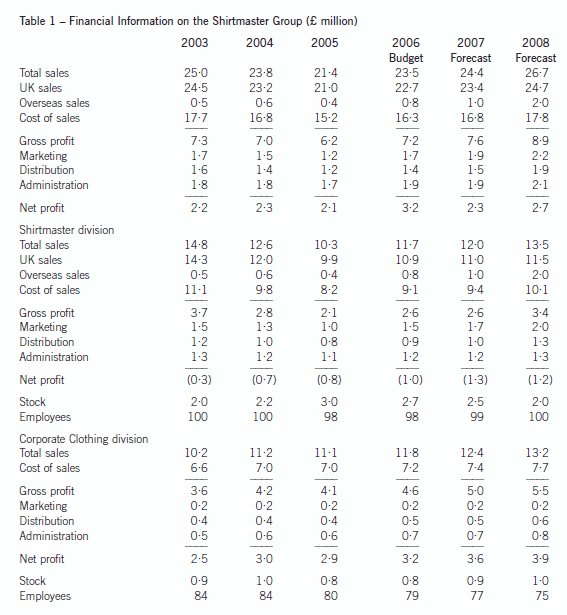1 IntroductionTony Masters, chairman and chief executive of the Shirtmaster Group, is worr
1 Introduction
Tony Masters, chairman and chief executive of the Shirtmaster Group, is worried. He has recently responded to his
senior management team’s concerns over the future of the Group by reluctantly agreeing to appoint an external
management consultant. The consultant’s brief is to fully analyse the performance of the privately owned company,
identify key strategic and operational problems and recommend a future strategy for the company. Tony is concerned
that the consultant’s report will seriously question his role in the company and the growth strategy he is proposing.
Group origins and structure
Tony’s father, Howard Masters, set up Shirtmaster in the 1950s. Howard was a skilled tailor and saw the potential
for designing and manufacturing a distinctive range of men’s shirts and ties marketed under the ‘Shirtmaster’ brand.
Howard set up a shirt manufacturing company with good access to the employee skills needed to design and make
shirts. Howard had recognised the opportunity to make distinctive shirts incorporating innovative design features
including the latest man-made fibres. In the 1960s London was a global fashion centre exploiting the UK’s leading
position in popular music. Men became much more fashion conscious, and were willing to pay premium prices for
clothes with style. and flair. Shirtmaster by the 1960s had built up a UK network of more than 2,000 small
independent clothing retailers. These retailers sold the full range of men’s wear including made-to-measure suits,
shirts and matching ties, shoes and other clothing accessories. Extensive and expensive TV and cinema advertising
supported the Shirtmaster brand.
The Shirtmaster Group is made up of two divisions – the Shirtmaster division which concentrates on the retail shirt
business and the Corporate Clothing division which supplies workwear to large industrial and commercial customers.
Corporate Clothing has similar origins to Shirtmaster, also being a family owned and managed business and is located
in the same town as Shirtmaster. It was set up to supply hardwearing jeans and workwear to the many factory workers
in the region. The decline of UK manufacturing and allied industries led to profitability problems and in 1990 the
Shirtmaster Group acquired it. Tony took over executive responsibility for the Group in 1996 and continues to act as
managing director for the Shirtmaster Division.
Shirtmaster division – operations and market environment
By 2006 the UK market for men’s shirts was very different to that of the 1960s and 1970s when Shirtmaster had
become one of the best known premium brands. In a mature market most of Shirtmaster’s competitors have
outsourced the making of their shirts to low cost manufacturers in Europe and the Far East. Shirtmaster is virtually
alone in maintaining a UK manufacturing base. Once a year Tony and the buyer for the division go to Asia and the
Far East, visiting cloth manufacturers and buying for stock. This stock, stored in the division’s warehouse, gives the
ability to create a wide range of shirt designs but creates real problems with excessive stock holdings and outdated
stock. Shirtmaster prides itself on its ability to respond to the demands of its small retail customers and the long-term
relationships built up with these retailers. Typically, these retailers order in small quantities and want quick delivery.
Shirtmaster has to introduce new shirt designs throughout the year, contrasting with the spring and autumn ranges
launched by its competitors. This creates real pressure on the small design team available.
The retail side of the shirt business has undergone even more fundamental change. Though the market for branded
shirts continues to exist, such shirts are increasingly sold through large departmental stores. There is increasing
competition between the shirt makers for the limited shelf space available in the departmental stores. Shopping
centres and malls are increasingly dominated by nationwide chains of specialist clothing retailers. They sell to the
premium segment of the market and are regarded as the trendsetters for the industry. These chains can develop
quickly, often using franchising to achieve rapid growth, and are increasingly international in scope. All of them require
their suppliers to make their clothes under the chain’s own label brand. Some have moved successfully into selling
via catalogues and the Internet. Finally, the UK supermarket chains have discovered the profitability of selling nonfood
goods. The shirts they sell are aimed at value for money rather than style, sourced wherever they can be made
most cheaply and sold under the supermarket’s own label. Small independent clothing retailers are declining both in
number and market share.
The Shirtmaster division, with its continued over-reliance for its sales on these small independent retailers, is
threatened by each of the retail driven changes, having neither the sales volume to compete on price nor the style. to
compete on fashion.
The Shirtmaster division’s international strategy
Tony’s answer to these changes is to make the Shirtmaster brand an international one. His initial strategy is to sell to
European clothing retailers and once established, move the brand into the fast growing consumer markets in Asia and
the Far East. He recognises that the division’s current UK focus means that working with a European partner is a
necessity. He has given the sales and marketing manager the job of finding major retailers, distributors or
manufacturers with whom they can make a strategic alliance and so help get the Shirtmaster range onto the shelves
of European clothing retailers.
Corporate Clothing division – operations and market environment
Corporate Clothing has in recent years implemented a major turnaround in its business as the market for corporate
clothing began to grow significantly. Corporate Clothing designs, manufactures and distributes a comprehensive range
of workwear for its corporate customers, sourcing much of its range from low cost foreign suppliers. It supplies the
corporate clothing requirements of large customers in the private and public sectors. Major contracts have been gained
with banks, airlines, airports and the police, fire and ambulance services.
The Corporate Clothing division supplies the whole range of workwear required and in the sizes needed for each
individual employee. Its designers work closely with the buyers in its large customers and the division’s sales benefit
from the regular introduction of new styles of uniforms and workwear. Corporate employers are increasingly aware of
the external image they need to project and the clothes their employees wear are the key to this image. Corporate
Clothing has invested heavily in manufacturing and IT systems to ensure that it meets the needs of its demanding
customers. It is particularly proud of its computer-aided design and manufacturing (CAD/CAM) systems, which can
be linked to its customers and allows designs to be updated and manufacturing alterations to be introduced with its
customers’ approval. Much of its success can be attributed to the ability to offer a customer service package in which
garments are stored by Corporate Clothing and distributed directly to the individual employee in personalised
workwear sets as and when required. The UK market for corporate workwear was worth £500 million in 2005.
Evidence suggests that the demand for corporate workwear is likely to continue to grow.
The Corporate Clothing division also has ambitions to enter the markets for corporate clothing in Europe and
recognises that might be most easily done through using a suitable strategic partner. There is friendly rivalry between
the two divisions but each operates largely independently of the other. Over the past 10 years the fortunes of the two
divisions have been completely reversed. Corporate Clothing now is a modest profit maker for the group – Shirtmaster
is consistently losing money.
Shirtmaster Group – future strategy
Tony is determined to re-establish Shirtmaster as a leading shirt brand in the UK and successfully launch the brand
in Europe. He sees a strategic alliance with a European partner as the key to achieving this ambition. Though he
welcomes the success of the Corporate Clothing division and recognises its potential in Europe, he remains
emotionally and strategically committed to restoring the fortunes of the Shirtmaster division. Unfortunately, his
autocratic style. of leadership tends to undermine the position of the senior management team at Shirtmaster. He
continues to play an active role in both the operational and strategic sides of the business and is both well known
and regarded by workers in the Shirtmaster division’s factory.
The initial feedback meeting with the management consultant has confirmed the concern that he is not delegating
sufficiently. The consultant commented that Tony’s influence could be felt throughout the Shirtmaster division.
Managers either try to anticipate the decisions they think he would make or, alternatively, not take the decisions until
he has given his approval. The end result is a division not able to meet the challenges of an increasingly competitive
retail marketplace, and losing both money and market share.

Required:
(a) Assess the strategic position and performance of the Shirtmaster Group and its divisions over the
2003–2005 period. Your analysis should make use of models where appropriate. (20 marks)
 搜題
搜題































